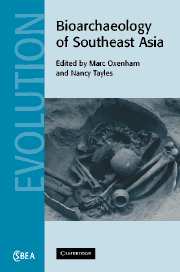Book contents
- Frontmatter
- Contents
- List of contributors
- Foreword: Emerging frontiers in the bioarchaeology of Southeast Asia
- Preface
- 1 Introduction: Southeast Asian bioarchaeology past and present
- Part I Morphological diversity, evolution and population relationships
- Part II Health, disease and quality of life
- Part III Conclusions
- Index
- References
1 - Introduction: Southeast Asian bioarchaeology past and present
Published online by Cambridge University Press: 18 November 2009
- Frontmatter
- Contents
- List of contributors
- Foreword: Emerging frontiers in the bioarchaeology of Southeast Asia
- Preface
- 1 Introduction: Southeast Asian bioarchaeology past and present
- Part I Morphological diversity, evolution and population relationships
- Part II Health, disease and quality of life
- Part III Conclusions
- Index
- References
Summary
When originally discussing and formulating the idea that eventually led to this volume we asked ourselves ‘is there a recognised need for a book on Southeast Asian bioarchaeology?’ ‘And does everyone know what bioarchaeology is anyway?’ We address the second question, ‘what is bioarchaeology?’, first. Human remains provide the only direct record of the biology of the people and the populations who created the ‘archaeological record’ and these are, therefore, central to any archaeological research. This is not to deny the fascination of the material culture, the environmental context, the settlement patterns and the mortuary practices of past peoples, it is nevertheless (and despite the reluctance of many archaeologists to admit it) axiomatic that human remains are the people who created the pots, the tools, the houses, the middens and the modified landscapes. As such they must, or ought to be, recognised as central to any research of past society that uses archaeology as the means of data recovery. This recognition of the value of human remains as a window into past peoples has gained momentum over recent decades (e.g. Larsen 1997, Cox and Mays 2000). With the development of appropriate means of interpreting the skeletal evidence beyond the simple description that the term ‘physical anthropology’ implies, those of us who are captured by the challenge are now seeing ourselves as human biologists. Having moved beyond taxonomy into the wider and richer world of biology, an appropriate epithet was sought.
- Type
- Chapter
- Information
- Bioarchaeology of Southeast Asia , pp. 1 - 30Publisher: Cambridge University PressPrint publication year: 2006
References
- 4
- Cited by



